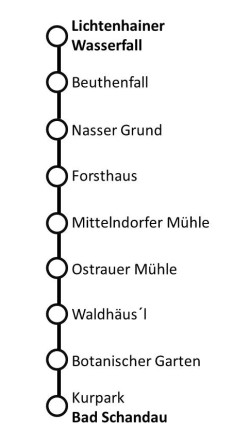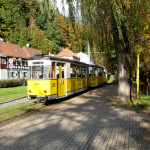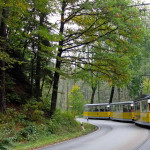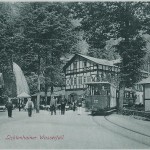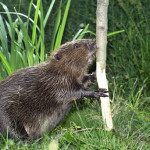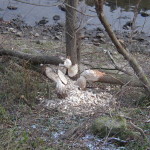Bad Schandau – Kirnitzsch Valley – Lichtenhain waterfall and back
Where else can you ride this classic urban means of transport in the middle of a national park? The Kirnitzsch Valley Tramway has been transporting visitors and hikers into Kirnitzsch Valley since 1898. It offers you “dry” views of the national park even on rainy days.
 The tramway has been through a lot: Floods, rock falls, fire … but it has been operating in the valley continually since 1898 with only some inevitable interruptions. The Bad Schandau health resort is the starting point for the tour of approximately 8 km.
The tramway has been through a lot: Floods, rock falls, fire … but it has been operating in the valley continually since 1898 with only some inevitable interruptions. The Bad Schandau health resort is the starting point for the tour of approximately 8 km.
Unfortunately, the traditional wagons are not wheelchair-accessible at all stops. However, since 2017 each final stop (Bad Schandau/Lichtenhainer Wasserfall) offers an elevated, handicapped accessible platform. In order to overcome the remaining gap to the wagon there are two mobile ramps available.
The wagons themselves offer enough space to transport a wheelchair, walker or stroller. But especially during weekends the trams might get crowded. Therefore, the tram service OVPS asks handicapped passengers to register: call 035022 548-16 or write to badschandau@ovps.de
After leaving the urban area of Bad Schandau the tram winds its way up the Kirnitzsch Valley, past the old mills to the final stop at the Lichtenhain waterfall. During the trip you will gain sights of the rocks of Saxon Switzerland on numerous occasions.
The small break until the next tram leaves for Bad Schandau again can be easily spent at the Lichtenhain waterfall. Next to the inn, the artificial dam is released every half an hour to make the famous waterfall come rushing down. This is also accessible by wheelchair.
 If you take a good look on your journey through the valley you may be lucky enough to discover a beaver or one of his works of art. The rodent has recently returned to the Kirnitzsch Valley. After the animals were considered extinct in Saxon Switzerland, due to the heavy reconstructions of the rivers and the value of their fur, they have been found again more frequently in recent years. Europe’s largest rodent prefers to eat herbaceous plants, grasses, and shoots and leaves of softwood trees, such as willows and poplars. Here they live in burrows in the ground. Beavers are also active in the winter, building up food reserves around their homes.
If you take a good look on your journey through the valley you may be lucky enough to discover a beaver or one of his works of art. The rodent has recently returned to the Kirnitzsch Valley. After the animals were considered extinct in Saxon Switzerland, due to the heavy reconstructions of the rivers and the value of their fur, they have been found again more frequently in recent years. Europe’s largest rodent prefers to eat herbaceous plants, grasses, and shoots and leaves of softwood trees, such as willows and poplars. Here they live in burrows in the ground. Beavers are also active in the winter, building up food reserves around their homes.








